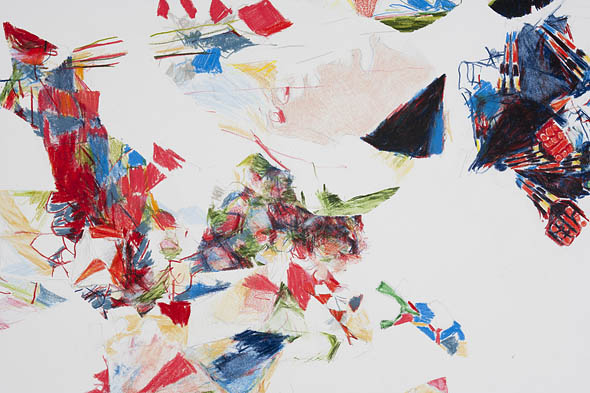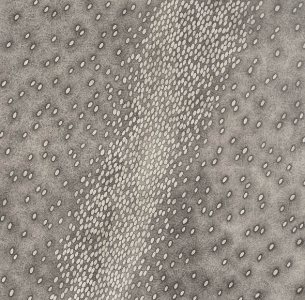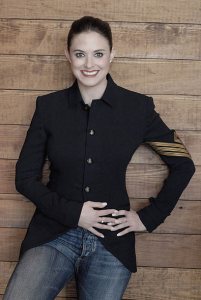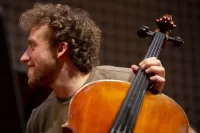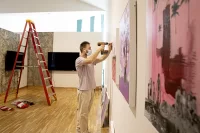
Museum of Art offers inside look at Wyeths, installment of Maine Drawing Project
Long recognized for the strength of its drawing collection, the Museum of Art reveals multiple dimensions of that medium in major exhibitions this summer.
As part of a statewide initiative exploring the art of drawing, the exhibition Emerging Dis/Order: Drawings by Amy Stacey Curtis, Alison Hildreth and Andrea Sulzer features new work by respected Maine artists who explore themes of memory and loss, order and chaos, and emerging and converging human behavior.
Meanwhile, drawings, watercolors and illustrated letters from one of America’s most famous artist families constitute Andrew and Jamie Wyeth: Selections from the Private Collection of Victoria Browning Wyeth.
Emerging Dis/Order opens with a museum reception at 4 p.m. Friday, June 10, and shows through Sept. 10. Opening the Wyeth exhibition is a lecture by Victoria Wyeth at 3:30 p.m. Saturday, June 11, in the Olin Arts Center Concert Hall, 75 Russell St., immediately followed by a reception in the museum at 4. The exhibition runs through Oct. 2.
On view through Aug. 30 in the museum’s Synergy Space is Selected Drawings and Photographs from the Marsden Hartley Memorial Collection. Located in the Olin Art Center, the museum is open to the public at no cost from 10 a.m. to 5 p.m. Tuesday-Saturday.
Emerging Dis/Order is part of 2011’s Where to Draw the Line: The Maine Drawing Project, a statewide visual arts initiative, developed by the Maine Curators Group, that represents a unique collaboration between Maine’s arts organizations. As part of the project, museums and galleries across Maine are offering exhibitions that focus on the process of drawing and how artists use it as a vehicle for creating diverse forms of visual expression.
Selections from the Private Collection of Victoria Browning Wyeth comprises an extraordinary selection of artworks by Andrew Wyeth and Jamie Wyeth. The show is assembled from the personal collection of Victoria Browning Wyeth ’01, and includes portraits of family members and neighbors now known as models for Andrew Wyeth, as well as Maine and Pennsylvania landscapes.
More about Emerging Dis/Order
Curtis, best-known for her interactive “solo-biennial” installations in unused mill spaces throughout Maine, has previously used drawings to support her themed installation projects. More recently, however, she has become fascinated with the possibilities of drawing as a medium in its own right, and her work has developed in profound ways.
Hildreth, well-known to Maine audiences as a printmaker and painter, also produces remarkable drawings, such as her Forthrights and Meanders, which are both narrative and journey. An artist interested in exploring interconnections between species and intersections between art and science, she says that “making art is my journal, a record of what compels and absorbs me. It is a method of questioning, investigating and discovering.”
Sulzer is acclaimed for making exceptionally detailed drawings that imbue dense, repetitive marks with, she says, “vertiginous, unsettling sense of space.” She is interested in the “way that memory fractures, distorts and collapses time and, in particular, how modern memory is overwhelmed by fragments that are impossible to ground in personal experience.”
“The Maine Drawing Project serves two purposes,” explains William Low, curator at the Bates museum. “First, it’s an opportunity for Maine art institutions to show the extent of the wonderful drawing collections that audiences do not often see. Second, it’s an effort to show the variety of artwork being produced by contemporary artists who are using drawing in new and interesting ways.
“Drawings are often an overlooked and underappreciated medium, often regarded as only ‘practice’ for finished works of art” in other media. “But many artists draw as their primary medium. And drawing is not just pencil on paper.”
Such collaborations among institutions result in a whole greater than the sum of the parts, notes Dan Mills, director of the Bates museum. “Doing so fosters partnerships, understanding and sharing of resources. The result is terrific for the statewide cultural community, and museum-goers can view a remarkable breadth and depth of drawings.”
More about Andrew and Jamie Wyeth
“One of the truly exciting aspects about working with Victoria’s collection is that many of the drawings have never been exhibited before,” says Low.
Including sketchbooks and early studies for prominent paintings, the exhibition affords “a rare opportunity to work with a collection that explores the working process of Andrew Wyeth,” he adds.
The collection is of particular interest also because of its personal nature, as it includes illustrated personal correspondence between Andrew Wyeth and his granddaughter. “It’s a pleasure to work with Victoria, whose enthusiasm and intimacy with the works brings extraordinary insight,” says Low.
This exhibition is generously supported by the Mr. and Mrs. Raymond J. Horowitz Foundation for the Arts.
Like the Wyeth show, Selected Drawings and Photographs from the Marsden Hartley Memorial Collection consists primarily of drawings, Mills adds. “Together, the exhibitions offer an extraordinary opportunity to view drawings by generations of artists with a strong association to Maine.”
